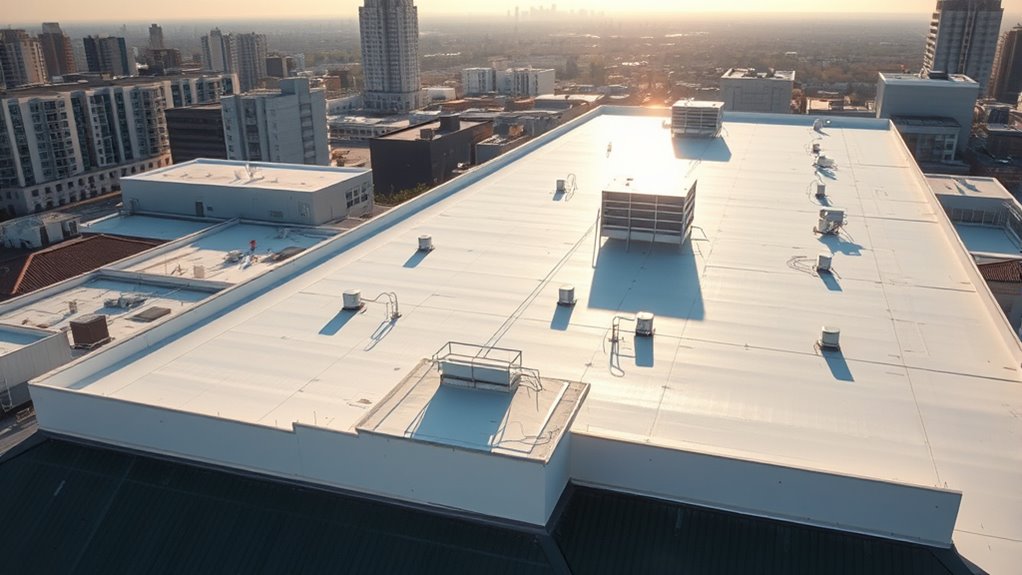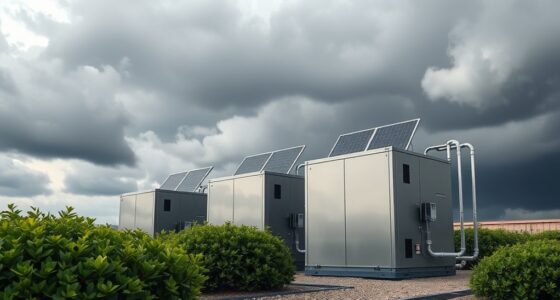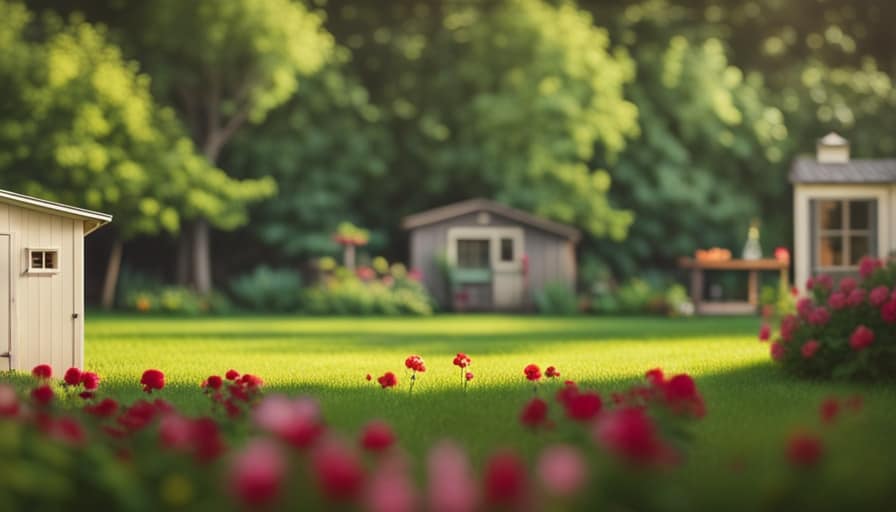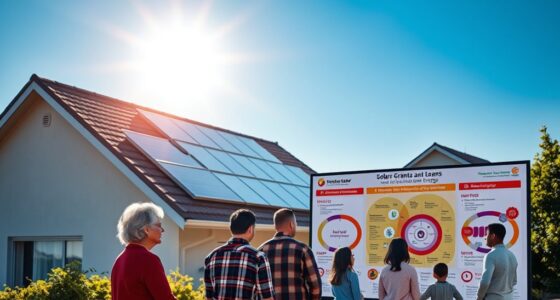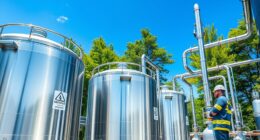Applying high-albedo roof coatings can indeed boost your solar panel output by around 4%, mainly by reflecting more sunlight and reducing rooftop temperatures. These coatings lower the heat transfer to panels, making them more efficient, especially during peak sunlight hours. Keep in mind that maintaining high reflectivity through regular cleaning and proper material choices enhances this benefit. To discover how to maximize these gains and prolong coating effectiveness, explore the strategies that follow.
Key Takeaways
- High-albedo coatings reflect more solar radiation, reducing roof temperature and enhancing solar panel efficiency.
- Cooler roof temperatures can improve PV module performance, leading to potential output increases around 4%.
- Proper cleaning and maintenance of reflective coatings sustain high albedo, maximizing energy gains.
- Material choices with high infrared emissivity help maintain panel output by keeping roof surfaces cooler.
- Combining reflective coatings with strategic solar panel placement can collectively boost system output by approximately 4%.
The Science Behind High-Albedo Coatings and Solar Panel Efficiency
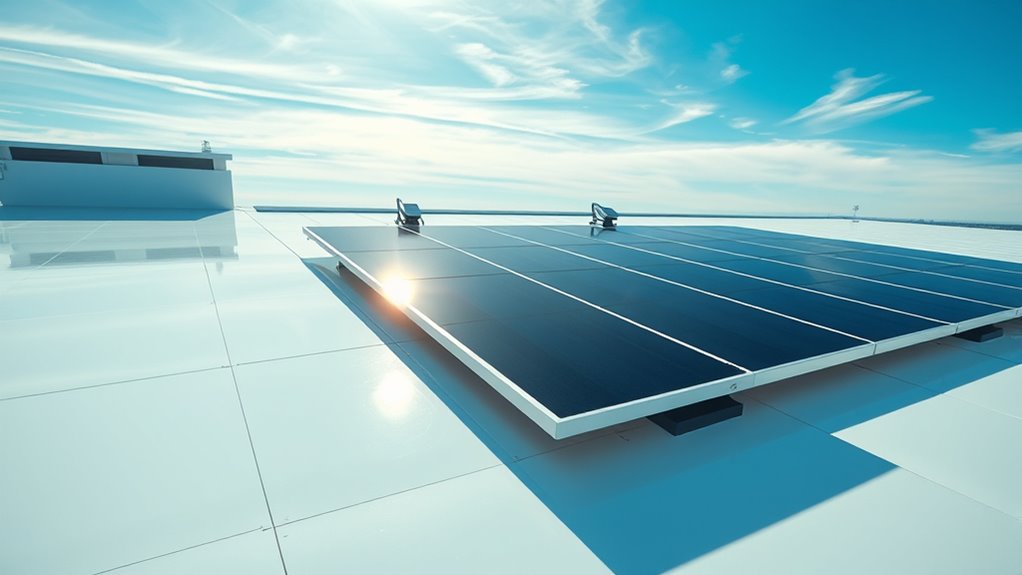
High-albedo coatings work by reflecting a larger portion of solar radiation than traditional roofing materials, which helps keep roof surfaces cooler. They achieve this through high solar reflectance across visible and near-infrared bands, minimizing heat absorption. Effective coatings also have high infrared emissivity, allowing heat to dissipate efficiently from the roof. Maintaining these properties over time is essential for consistent performance, as dirt and wear can reduce reflectance. These coatings typically have reflectance levels much higher than standard black roofs, which only reflect about 5%. By bouncing back more sunlight, high-albedo coatings lower rooftop temperatures, directly benefiting solar panel efficiency. Cooler panels operate more efficiently, reducing thermal losses and boosting energy output. This science basis underpins the potential for improved solar performance and energy savings with reflective roof coatings. Research shows that these coatings can also contribute to reducing the urban heat island effect, further enhancing environmental benefits. Additionally, advancements in coating durability help sustain high reflectance levels over extended periods, ensuring long-term efficiency gains.
How Reflective Roof Coatings Reduce Ambient Temperature
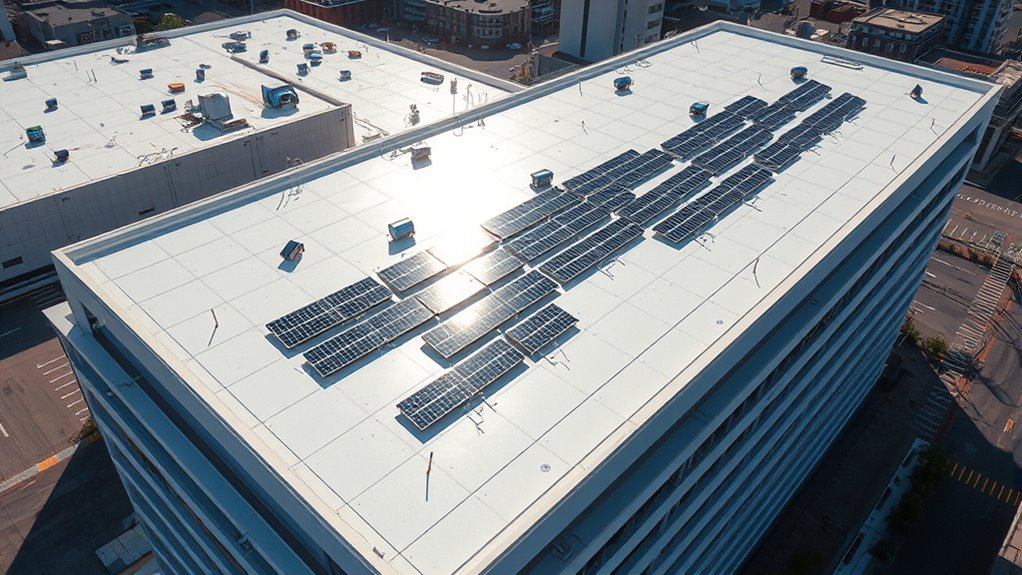
Reflective roof coatings play a significant role in lowering ambient temperatures around buildings by reducing the heat emitted from rooftops. They reflect more solar radiation, decreasing heat transfer into structures and the surrounding air. This cooling effect is most noticeable during peak sunlight hours, with surface temperatures dropping up to 42°C. Maintaining high albedo through regular cleaning guarantees sustained energy savings and temperature reduction.
| Benefit | Impact |
|---|---|
| Reduced rooftop temperatures | Up to 36°C lower in hot climates |
| Lower ambient air temps | Cooler microclimate, less urban heat island effect |
| Enhanced energy efficiency | Less cooling needed, lower utility costs |
The Impact of Dirt and Weathering on Albedo Over Time
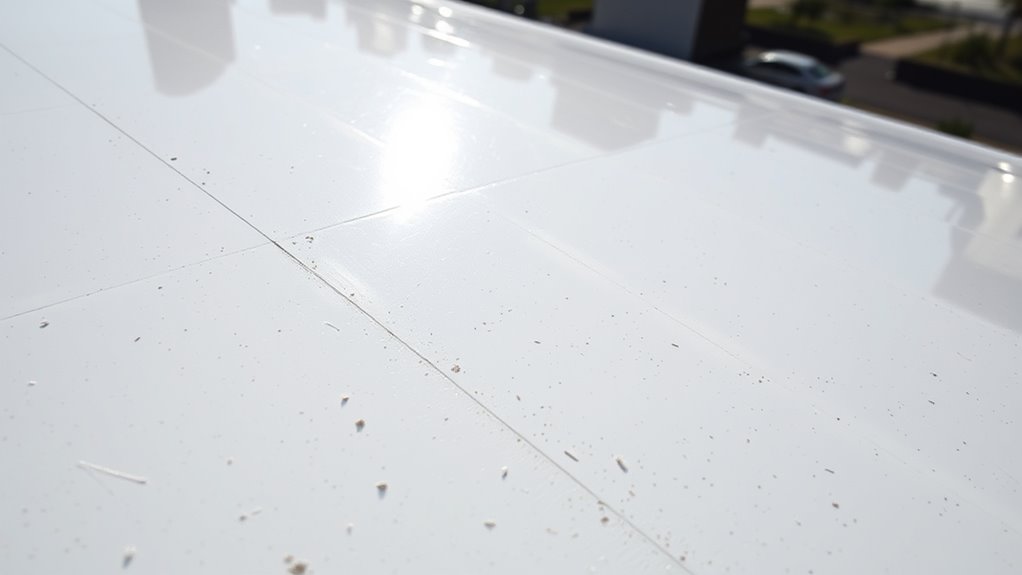
Dirt, dust, and pollutants quickly accumulate on roof surfaces, considerably reducing their ability to reflect sunlight. Most albedo loss happens within the first two months, with about 70% of annual degradation occurring early on. After the first year, the rate of decline slows, with total loss ranging from 5% to 20% over six years, depending on coating type. Dirt and soil deposits, especially in urban areas, contain pollutants like carbon and hydrocarbons that diminish reflectivity. Regular cleaning can temporarily restore up to 90% of the surface’s albedo, but it’s labor-intensive and not cost-effective long-term. Weathering from UV exposure and rain further degrades coatings, altering surface properties and increasing dirt accumulation, which accelerates albedo loss over time. Additionally, exposure to environmental elements can influence the durability of preppy roof coatings, affecting their long-term performance and efficiency.
Material Choices for Durable and Effective Roof Coatings
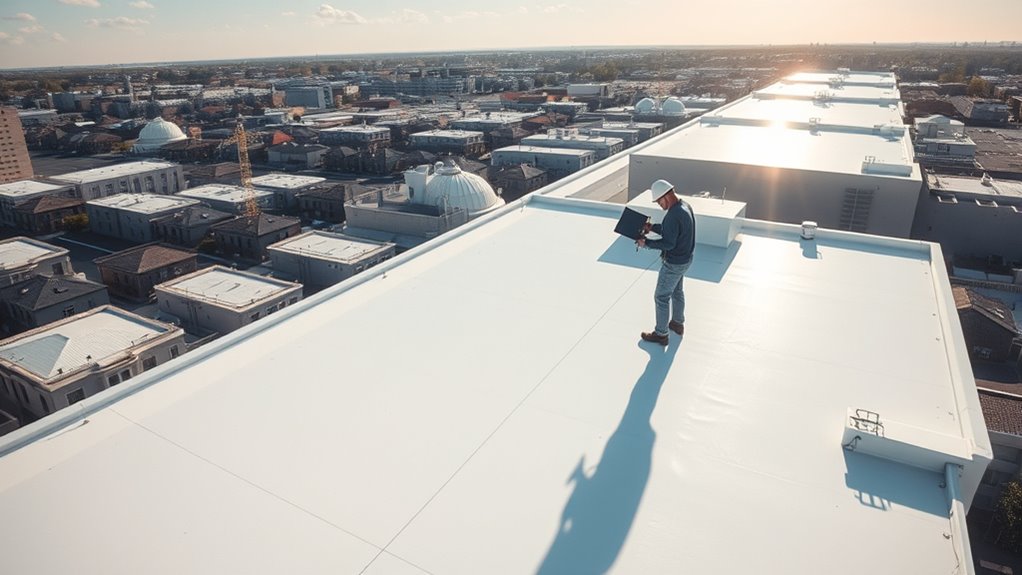
Choosing the right materials for roof coatings is essential to guarantee long-lasting performance and high solar reflectance. Your selection impacts durability, UV resistance, and overall effectiveness.
- Pigments and Additives: Titanium dioxide provides high reflectance and UV absorption, especially when surface-treated with aluminum hydroxide for durability. Be aware that some coatings may absorb slightly in near-infrared, affecting thermal performance.
- Polymer and Binder Systems: Silicone coatings excel at UV resistance and ponding water, while urethane offers strong adhesion and impact resistance. Butyl rubber is highly durable and flexible, but more costly.
- Durability Factors: Coating longevity depends on formulation and surface prep. Silicone and urethane resist weathering better, maintaining high reflectance longer.
- Optical Properties: Spectral reflectance depends on chemical composition; optimizing for visible and near-infrared bands boosts cooling benefits.
Quantifying the Energy Savings and Cost Benefits
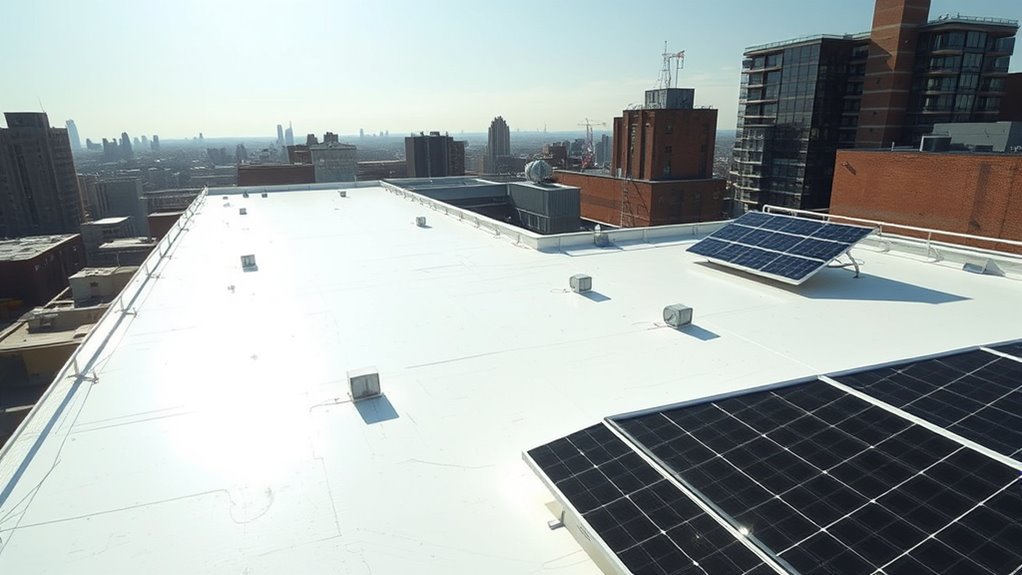
High-albedo roof coatings can deliver quick financial returns, often with payback periods as short as 1.5 years. These coatings not only lower cooling costs but also boost solar panel efficiency, leading to long-term energy savings. High-albedo surfaces reflect more sunlight, increasing irradiance for PV panels, especially bifacial types. Understanding these benefits helps you evaluate the true value and cost-effectiveness of investing in high-albedo solutions. Additionally, solar irradiance can be significantly increased on reflective surfaces, further enhancing energy output.
Financial Return on Investment
Implementing high-albedo roof coatings can provide significant financial benefits by reducing energy costs and improving return on investment. Here’s how it pays off:
- Energy savings: You can see average cooling energy reductions of 19–25%, translating to lower utility bills—such as 7.4 kWh daily savings in homes and substantial reductions in commercial buildings.
- Peak demand reduction: Expect peak demand drops of around 0.4 kW, which can cut demand charges and lower overall utility costs.
- Durability factors: Regular washing and maintenance help sustain high reflectance, preserving energy savings over time and maximizing ROI.
- Climate impact: In hot, sunny areas like Phoenix, annual HVAC savings reach about 25.5 kWh/m², boosting financial returns in suitable climates.
- Long-term benefits: The combination of energy savings and increased roof longevity contributes to a faster payback period and higher overall cost-effectiveness compared to traditional roofing materials.
Long-Term Energy Reductions
Over time, the energy savings from high-albedo roof coatings tend to diminish due to dirt buildup and weathering. Most of the albedo loss occurs within the first two months, with up to 70% of the initial reduction happening early on. After the first year, savings decline by roughly 20%, as albedo drops from around 0.7 to 0.53–0.58. This deterioration leads to a decrease in cooling energy savings from about 40% to near 32%. While roof washing can restore some reflectance, it’s rarely cost-effective solely for energy savings. Nonetheless, even with degradation, high-albedo coatings continue to deliver noticeable reductions in cooling loads and peak demand, especially in hot, sunny climates. These long-term benefits help lower energy costs and ease grid strain during peak hours.
Strategies for Maintaining High Albedo and Maximizing Gains
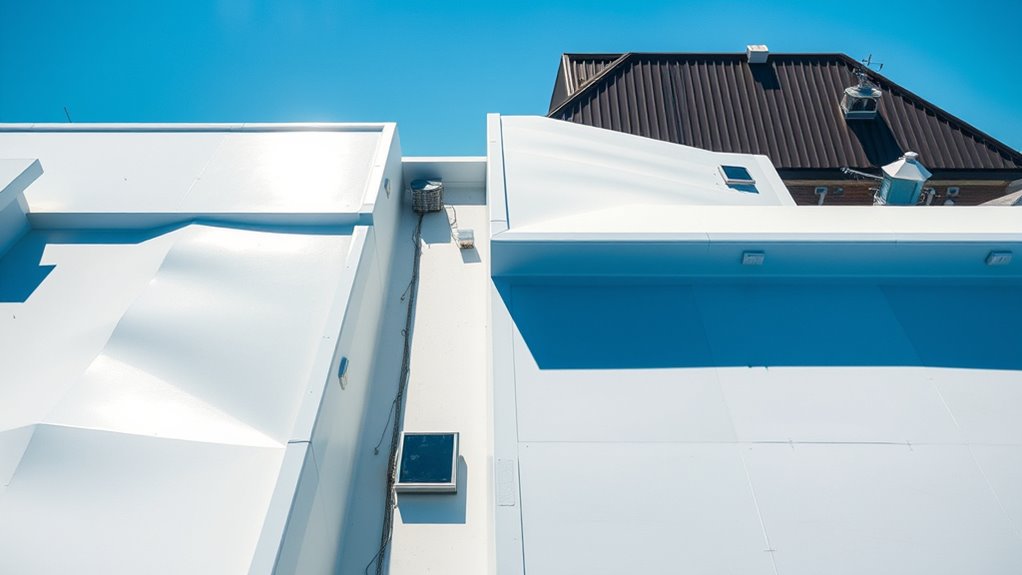
To keep your roof’s albedo high, regular cleaning is vital to remove dirt and debris that can diminish reflectivity. Choosing durable, weather-resistant coatings and applying protective layers helps maintain performance over time, even in harsh conditions. Higher reflectivity can increase solar system energy output by approximately 20-30%. Incorporating coating longevity practices ensures the coating remains effective longer, reducing the need for frequent reapplications. By implementing these strategies, you can maximize energy savings and ensure your roof coating continues to deliver long-term benefits.
Regular Cleaning Practices
Regular cleaning is essential for maintaining the high reflectivity of roof coatings and maximizing their energy-saving benefits. By keeping your roof free of dirt and debris, you guarantee the coating stays highly reflective, helping reduce cooling costs. Regular cleaning also prevents the buildup of algae and grime that can lower reflectivity and diminish performance. To keep your roof in top shape, follow these practices:
- Use soft washing with low-pressure water and biodegradable solutions to clean without damage.
- Schedule seasonal cleanings in spring and fall to remove seasonal debris.
- Conduct regular inspections to identify signs like dark streaks or algae growth early.
- Clean after severe weather events to prevent debris accumulation and potential damage. Proper cleaning methods help preserve the high albedo of reflective coatings, ensuring maximum energy efficiency over time.
Consistent maintenance prolongs the roof’s lifespan and preserves its energy efficiency.
Material Selection and Durability
Selecting the right materials is essential for maintaining high reflectivity and ensuring your roof coating performs effectively over time. You should choose pigments like titanium dioxide for their high reflectance, but be aware that UV exposure can cause fading and reduce effectiveness. Surface treatments, such as aluminum hydroxide, can enhance durability by protecting pigments from degradation. Ensuring the coating maintains high reflectance and emittance in visible and near-infrared bands is key to sustained cooling benefits. Pay attention to coating thickness; sub-standard layers lower reflectivity. The substrate’s texture, slope, and material also impact durability and albedo retention. Since most degradation occurs within the first two months, selecting materials with proven fade resistance and UV stability helps maximize long-term performance and energy savings.
Weatherproofing and Protective Coatings
Weatherproofing and protective coatings are essential for maintaining high albedo and maximizing cooling benefits over time. They prevent dirt, dust, and pollutants from reducing reflectivity, ensuring your roof stays effective. To do this effectively: 1. Regular cleaning removes particulate buildup, especially in polluted or wet environments. 2. Use hydrophobic or self-cleaning coatings that repel dirt and facilitate rainwater washing. 3. Apply water-resistant formulations that resist soiling and extend service life in humid climates. 4. Choose coatings with UV resistance and elasticity to prevent degradation from sunlight and temperature changes. Applying reflective coatings with high UV resistance helps maintain their effectiveness in hot climates. Implementing these strategies helps sustain high reflectance, reduces maintenance needs, and prolongs the coating’s lifespan, ensuring your roof keeps performing year-round.
Integrating High-Albedo Coatings With Solar Panel Installations
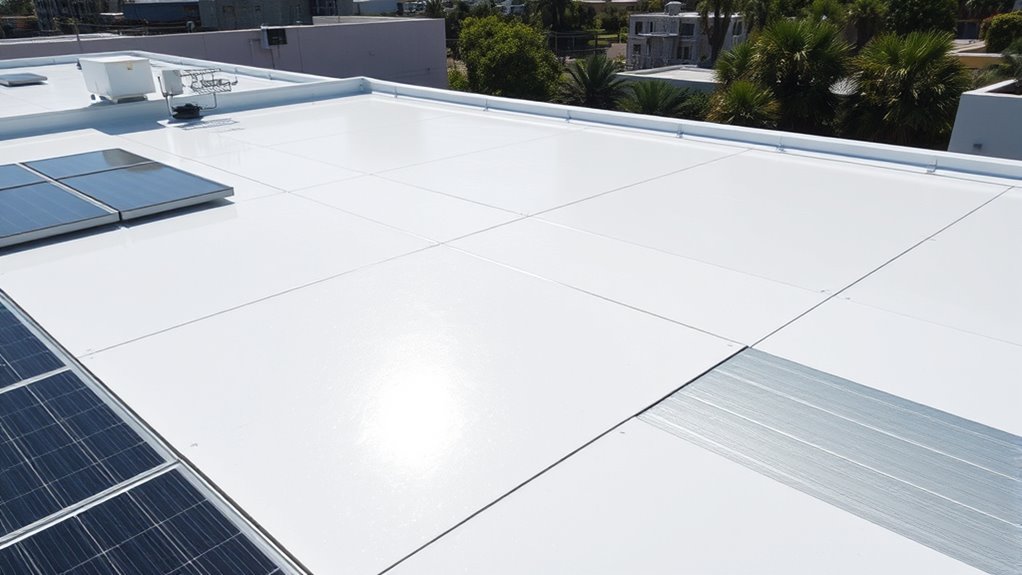
How can high-albedo roof coatings be effectively integrated with solar panel installations to maximize energy efficiency? First, select coatings with high solar reflectance and infrared emissivity to boost cooling and reduce panel temperatures. Apply the coatings strategically to reflect sunlight toward the solar panels, especially for bifacial systems that can capture reflected light. Guarantee the roof surface is smooth and clean to maintain high reflectivity over time, as dirt buildup diminishes effectiveness. Incorporate design considerations that optimize the angle and placement of panels to benefit from reflected sunlight. Cost-effectiveness plays a key role; with payback periods potentially as short as 1.5 years, investing in high-albedo coatings makes sense. High-albedo coatings can also help mitigate the urban heat island effect, which further improves overall building energy performance. Additionally, maintaining proper roof maintenance ensures sustained high reflectivity and performance. Combining these strategies enhances power output and prolongs panel lifespan, maximizing overall energy gains.
Frequently Asked Questions
How Long Do High-Albedo Coatings Typically Maintain Their Reflectivity?
You’re wondering how long high-albedo coatings keep their reflectivity. Typically, they retain their effectiveness for 10 to 15 years, but their reflectance can decline by about 0.15 in the first year due to dirt, debris, and surface texture. Regular maintenance like cleaning or applying protective topcoats can help prolong their reflectivity, ensuring you maximize the cooling and energy efficiency benefits over their lifespan.
Can High-Albedo Coatings Be Applied on All Types of Roofing Materials?
Think of high-albedo coatings as versatile tools that can adapt to many roofing surfaces. You can apply them to metal, asphalt, cementitious, and other materials, but success depends on proper surface prep and choosing the right coating. You need to take into account the material’s durability and environmental exposure. While they’re flexible, making sure the coating matches your roof type ensures it performs well and lasts longer.
Do Dirt and Pollution Significantly Reduce the Coatings’ Effectiveness?
Dirt and pollution can considerably reduce a coating’s effectiveness by decreasing its reflectivity. Dirt can lower albedo by up to 20%, especially within the first two months, and pollution adds to this decline by depositing particles on the surface. Regular cleaning helps restore reflectivity, but over time, both dirt and pollution can cause lasting damage. Monitoring and maintenance are key to maintaining ideal coating performance and energy savings.
What Is the Typical Cost Difference Between Reflective and Standard Roof Coatings?
Imagine choosing between a shining, reflective mirror and a basic, matte wall. Reflective roof coatings usually cost about 20% more than standard ones, like buying a premium paint. While standard coatings save money upfront, reflective options offer long-term benefits like energy savings and durability. Expect to pay roughly $0.50 to $4.50 per square foot for reflective coatings, compared to $0.15 to $1.50 for standard.
How Often Should Roofs Be Cleaned to Sustain Maximum Albedo Performance?
You should clean your roof every 6 to 12 months to keep its reflectivity high. In areas with lots of debris, like near trees or busy roads, cleaning every 3 to 4 months is better. After severe weather, inspect and clean right away to remove dirt and debris. Regular cleaning helps maintain maximum albedo, boosting energy savings and prolonging your roof’s lifespan.
Conclusion
Think of high-albedo roof coatings as a cool, reflective shield that keeps your solar panels basking in the sun’s energy. By boosting your roof’s reflectivity, you not only protect your panels from overheating but also unleash extra power, like adding a turbo boost to your system. With proper maintenance, this bright armor can keep your energy savings shining brightly for years. Embrace this smart upgrade and watch your solar investment reach new heights.
I’m Theodore, and I love tiny houses. In fact, I’m the author of Tiny House 43, a book about tiny houses that are also tree houses. I think they’re magical places where imaginations can run wild and adventures are just waiting to happen.
While tree houses are often associated with childhood, they can be the perfect adult retreat. They offer a cozy space to relax and unwind, surrounded by nature. And since they’re typically built on stilts or raised platforms, they offer stunning views that traditional homes simply can’t match.
If you’re looking for a unique and romantic getaway, a tree house tiny house might just be the perfect option.
